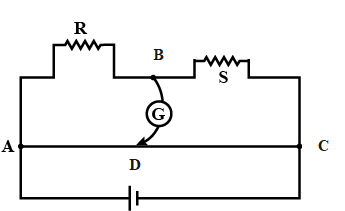
In a meter bridge, the null point is found at a distance of 60 cm from A, if now a resistance of is $5\Omega $ is connected in series with S and the null point occurs at 50 cm. Determine the values of R and S.

Answer
216.3k+ views
Hint: We know that a meter bridge also called a slide wire bridge is an instrument that works on the principle of a Wheatstone bridge. A meter bridge is used in finding the unknown resistance of a conductor as that of in a Wheatstone bridge. The reason why this bridge is called the Meter Bridge is because of the fact that it works on the Wheatstone bridge's principle. So, people also popularly call it as Wheatstone's meter bridge. Another thing is that the wire length used in this circuit is of 1 meter, so it has got its name as a meter bridge.
Complete step by step answer
We know that the jockey is used to sliding on the bridge wire. It is a metal rod with one end as a knife edge. Now adjust the value of resistance in the resistance box and slide the jockey along the wire. This process is to be done until the galvanometer shows a zero or null deflection. In potentiometer experiment, null point is obtained at a particular point for a cell on potentiometer wire x cm long. If the length of the potentiometer wire is increased without changing the cell.
It can be said that Constantan is used for meter bridge wire because its temperature coefficient of resistance is almost negligible due to which the resistance of the wire does not change with increase in temperature of the wire due to flow of current. Sensitivity of metre bridge is the accuracy to measure the value of current. a bridge is most sensitive when all resistance is of the same order.
In first case, $\dfrac{R}{S}=\dfrac{60}{100-60}=\dfrac{3}{2}$
In second case, $\dfrac{R}{S}+5=\dfrac{50}{50}=1$ or $R=S+5$
From the first case, $S+\dfrac{5}{S}=\dfrac{3}{2}$ or $2 S+10=3 S$
or $S=10 \Omega$ and $R=10+5=15 \Omega$
Note We know that the Wheatstone bridge works on the principle of null deflection, i.e. the ratio of their resistances is equal and no current flows through the circuit. Under normal conditions, the bridge is in the unbalanced condition where current flows through the galvanometer. The Wheatstone Bridge circuit is nothing more than two simple series-parallel arrangements of resistances connected between a voltage supply terminal and ground producing zero voltage difference between the two parallel branches when balanced. The Wheatstone bridge is used for measuring the very low resistance values precisely. Wheatstone bridge along with an operational amplifier is used to measure the physical parameters like temperature, strain, light, etc.
Complete step by step answer
We know that the jockey is used to sliding on the bridge wire. It is a metal rod with one end as a knife edge. Now adjust the value of resistance in the resistance box and slide the jockey along the wire. This process is to be done until the galvanometer shows a zero or null deflection. In potentiometer experiment, null point is obtained at a particular point for a cell on potentiometer wire x cm long. If the length of the potentiometer wire is increased without changing the cell.
It can be said that Constantan is used for meter bridge wire because its temperature coefficient of resistance is almost negligible due to which the resistance of the wire does not change with increase in temperature of the wire due to flow of current. Sensitivity of metre bridge is the accuracy to measure the value of current. a bridge is most sensitive when all resistance is of the same order.
In first case, $\dfrac{R}{S}=\dfrac{60}{100-60}=\dfrac{3}{2}$
In second case, $\dfrac{R}{S}+5=\dfrac{50}{50}=1$ or $R=S+5$
From the first case, $S+\dfrac{5}{S}=\dfrac{3}{2}$ or $2 S+10=3 S$
or $S=10 \Omega$ and $R=10+5=15 \Omega$
Note We know that the Wheatstone bridge works on the principle of null deflection, i.e. the ratio of their resistances is equal and no current flows through the circuit. Under normal conditions, the bridge is in the unbalanced condition where current flows through the galvanometer. The Wheatstone Bridge circuit is nothing more than two simple series-parallel arrangements of resistances connected between a voltage supply terminal and ground producing zero voltage difference between the two parallel branches when balanced. The Wheatstone bridge is used for measuring the very low resistance values precisely. Wheatstone bridge along with an operational amplifier is used to measure the physical parameters like temperature, strain, light, etc.
Recently Updated Pages
Wheatstone Bridge Explained: Working, Formula & Uses

Young’s Double Slit Experiment Derivation Explained

JEE Atomic Structure and Chemical Bonding important Concepts and Tips

JEE Amino Acids and Peptides Important Concepts and Tips for Exam Preparation

Electricity and Magnetism Explained: Key Concepts & Applications

Chemical Properties of Hydrogen - Important Concepts for JEE Exam Preparation

Trending doubts
JEE Main 2026: Application Form Open, Exam Dates, Syllabus, Eligibility & Question Papers

Derivation of Equation of Trajectory Explained for Students

Hybridisation in Chemistry – Concept, Types & Applications

Understanding the Angle of Deviation in a Prism

Understanding Collisions: Types and Examples for Students

How to Convert a Galvanometer into an Ammeter or Voltmeter

Other Pages
JEE Advanced Marks vs Ranks 2025: Understanding Category-wise Qualifying Marks and Previous Year Cut-offs

Ideal and Non-Ideal Solutions Explained for Class 12 Chemistry

Degree of Dissociation: Meaning, Formula, Calculation & Uses

Understanding Electromagnetic Waves and Their Importance

Understanding the Electric Field of a Uniformly Charged Ring

Understanding Average and RMS Value in Electrical Circuits




